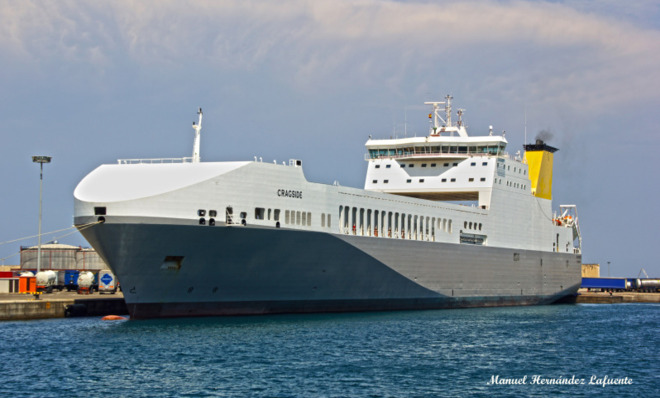The U.S. Navy is quietly building a big, secretive special operations 'mothership'
Will commandos get jet skis? Oh yes.


The U.S. Navy is quietly converting a 633-foot-long cargo ship into a secretive helicopter carrier with facilities for supporting a large contingent of Special Operations forces and all their gear, including jet skis.
Yes, jet skis.
And here's the really weird thing: almost nobody is talking about the new "mothership" vessel, even though it could significantly expand America's at-sea commando footprint.
The Week
Escape your echo chamber. Get the facts behind the news, plus analysis from multiple perspectives.

Sign up for The Week's Free Newsletters
From our morning news briefing to a weekly Good News Newsletter, get the best of The Week delivered directly to your inbox.
From our morning news briefing to a weekly Good News Newsletter, get the best of The Week delivered directly to your inbox.
In November, Military Sealift Command — America's quasi-civilian fleet of more than 100 specialized but lightly armed vessels — awarded an initial $73-million contract to shipping giant Maersk to convert one of its cargo ships to a so-called "Maritime Support Vessel" standard.
Maersk tapped the 30,000-ton displacement M/V Cragside, built in 2011. After enduring a legal protest by rival Crowley, in January Maersk sent Cragside to the Gulf of Mexico for military modifications, most likely at the BAE shipyard upriver in Alabama.
The contract, extendable for up to four years, could be worth up to $143 million. The militarized Cragside could deploy as early as November this year.
MSC is adding a bunch of new hardware to Cragside to allow the vessel to function as a floating base for up to 200 troops and their weapons plus small boats, helicopters and the aforementioned jet skis, which the Navy and Air Force have begun buying and which Navy SEALs could use to sneak along enemy coastlines.
A free daily email with the biggest news stories of the day – and the best features from TheWeek.com
Cragside should be able to sail 8,000 miles at a time at speeds up to 20 knots and in 20-foot seas, needing resupply only every 45 days. The shipyard is adding a highly-secure communications room, a gym and weapons lockers. After all, you can't house all those Army Delta Force troopers and SEALs without ample weapons lockers and gyms.
The sleek, capacious ship — already fitted with a rear ramp for loading vehicles — is also getting a flight deck big enough for the largest, heaviest U.S. military helicopter, the Navy's MH-53E. Cragside will also be able to support Army Apache gunships, Navy patrol helicopters, Special Operations Command Little Bird attack copters, and even Marine and Air Force V-22 tiltrotors.
Cragside's hangar must be big enough to hold two Navy helicopters at the same time for maintenance — and has to have the special, subtle lighting that allows crews to use night-vision goggles.
Add it all up, and you've got a floating air base, barracks and headquarters — all in a package that, because it looks just like a civilian cargo ship, should be able to avoid easy identification. "This is going to be a seriously capable ship," commented Tim Colton, a maritime consultant.
And a seriously capable ship that many close observers of the Navy don't even know exists. It's not the that government is covering up Cragside — the call for bids went out through normal public channels. But the vague official descriptions of the vessel's purpose have helped her escape wide notice.
When Seapower magazine called Sealift Command for comment, it got a predictably terse response. "We can't provide details relating to the ship's mission," MSC spokesman Jim Marconi said.
Mothership history
Floating bases like Cragside are all the rage in the Pentagon. Using ships as outposts is a convenient way to avoid all the dicey politics of setting up U.S. military bases on land in some foreign country. Also, sea bases can relocate quickly.
With budgets shrinking and the cost of new warships going up, up, up, the Navy is trying out a lot of methods for maintaining America's sea presence — cheaply.
Cragside's $35-million annual cost is nothing to sneeze at, but it's still less pricey than designing and building a new warship from scratch — provided the Navy's lease lasts only a decade or so. After 20 years of use, it probably becomes cheaper to own a support ship than to rent one.
And indeed the Navy already owns, or is building, several floating bases similar to Cragside. Sealift Command operates nine small Special Warfare Support Ships. One of them, M/V C-Champion, has helped supply and transport American commandos in the Philippines — and made the news in 2011 when her crew rescued five people from a capsized boat.
There's Ponce, a retired 1970s-vintage amphibious assault ship that the sailing branch brought back into service in 2012 as a so-called "Afloat Forward Staging Base" for the Persian Gulf.
Today the upgraded Ponce hosts minehunters and other specialized troops. And sometime this year the veteran ship is getting a brand-new, experimental defense laser.
Ponce is reportedly good for another two years of service, after which she will be replaced by a pair of purpose-built AFSBs currently under construction in San Diego at a cost of $500 million apiece. The new AFSBs are more than 800 feet long and displace a whopping 80,000 tons — more than twice as much as Cragside.
The Navy is also buying 10 fast catamaran transports for Sealift Command that, while smaller than Cragside, could also host commandos and helicopters.
The Navy reckons that an AFSB — and likewise an MSV like Cragside — can do much of the work of a billion-dollar amphibious assault ship. The only exception is a World War II-style beach assault, which probably calls for a more heavily armed and armored ship that can fend off determined enemy attacks.
Which means motherships like Cragside — some secretive, others totally above board — could become an even bigger part of the U.S. fleet, jet skis and all. Maybe soon people will even start noticing.
From drones to AKs, high technology to low politics, War is Boring explores how and why we fight above, on, and below an angry world. Sign up for its daily email update here or to it's RSS feed here.
More from War is Boring...
-
 Biggest political break-ups and make-ups of 2025
Biggest political break-ups and make-ups of 2025The Explainer From Trump and Musk to the UK and the EU, Christmas wouldn’t be Christmas without a round-up of the year’s relationship drama
-
 Why 2025 was a pivotal year for AI
Why 2025 was a pivotal year for AITalking Point The ‘hype’ and ‘hopes’ around artificial intelligence are ‘like nothing the world has seen before’
-
 The best drama TV series of 2025
The best drama TV series of 2025the week recommends From the horrors of death to the hive-mind apocalypse, TV is far from out of great ideas